
Concept explainers
Product pricing using the cost-plus approach methods; differential analysis for accepting additional business
Crystal Displays Inc. recently began production of a new product, flat panel displays, which required the investment of $1,500,000 in assets. The costs of producing and selling 5,000 units of flat panel displays are estimated as follows:

Crystal Displays Inc. is currently considering establishing a selling price for flat panel displays. The president of Crystal Displays has decided to use the cost-plus approach to product pricing and has indicated that the displays must earn a 15% return on invested assets.
Instructions
- 1. Determine the amount of desired profit from the production and sale of flat panel displays.
- 2. Assuming that the product cost method is used, determine (A) the cost amount per unit, (B) the markup percentage, and (C) the selling price of flat panel displays.
- 3. (Appendix) Assuming that the total cost method is used, determine (A) the cost amount per unit, (B) the markup percentage (rounded to two decimal places), and (C) the selling price of flat panel displays. (Round markup to nearest whole dollar.)
- 4. (Appendix) Assuming that the variable cost method is used, determine (A) the cost amount per unit, (B) the markup percentage (rounded to two decimal places), and (C) the selling price of flat panel displays. (Round markup to nearest whole dollar.)
- 5. Comment on any additional considerations that could influence establishing the selling price for flat panel displays.
- 6. Assume that as of August 1, 3,000 units of flat panel displays have been produced and sold during the current year. Analysis of the domestic market indicates that 2,000 additional units are expected to be sold during the remainder of the year at the normal product price determined under the product cost method. On August 3, Crystal Displays Inc. received an offer from Maple Leaf Visual Inc. for 800 units of flat panel displays at $225 each. Maple Leaf Visual Inc. will market the units in Canada under its own brand name, and no variable selling and administrative expenses associated with the sale will be incurred by Crystal Displays Inc. The additional business is not expected to affect the domestic sales of flat panel displays, and the additional units could be produced using existing factory, selling, and administrative capacity.
- A. Prepare a differential analysis of the proposed sale to Maple Leaf Visual Inc.
- B. Based on the differential analysis in part (A), should the proposal be accepted?
1.
Ascertain the desired profit of Company CD.
Explanation of Solution
Product pricing: Product pricing is the method used for fixing the price for the products sold or the services offered to the consumers.
Product cost pricing: Product cost pricing is a pricing technique which sums up the costs involved in the production of the product alone and the markup is added to the sum.
Total cost pricing: Total cost pricing is a pricing technique which sums up all the costs involved in the production of the product and the markup is added to the sum.
Total Variable Cost: Total variable cost refers to the costs involved in the production of the product.
Markup Percentage: The markup percentage is the percentage of additional costs added to the product cost to get the selling price of the product.
Selling Price: Selling price is calculated by summing up the product cost per unit and the per unit markup cost
Desired Profit: Company CD aims at earning a profit of 15% of the total investment made of $1,500,000.
Calculate the desired profit of Company CD.
Hence, the desired profit of Company CD is $225,000
2.
Calculate on the basis of product cost concept, for Company CD
- i. Cost per unit
- ii. Markup percentage
- iii. Selling price of flat panel displays
Explanation of Solution
Product cost pricing: Product cost pricing is a pricing technique which sums up the costs involved in the production of the product alone and the markup is added to the sum.
i)
Calculate the cost per unit of flat panel display.
| Variable Cost (1) | $1,000,000 |
| Fixed Cost | $250,000 |
| Total | $1,250,000 |
| Divide by: Number of units | 5,000 |
| Cost per unit | $250 |
|
(Table 1) |
Hence, the cost per unit of flat panel display is $250.
Working Note:
(1) Calculate the variable cost.
ii)
Calculate the markup percentage of flat panel display.
Hence, the markup percentage of flat panel display is 44%,
iii)
Calculate the selling price per unit of flat panel display
| Cost per unit | $250 |
| Markup per unit | $110 |
| Selling price per unit | $360 |
(Table 2)
Hence, the selling price per unit of flat panel display is $360.
3.
Calculate on the basis of total cost concept, for Company CD
- i. Cost per unit
- ii. Markup percentage
- iii. Selling price of flat panel displays
Explanation of Solution
Total cost pricing: Total cost pricing is a pricing technique which sums up all the costs involved in the production of the product and the markup is added to the sum.
i)
Calculate the cost per unit of flat panel display.
| Variable Cost | $1,175,000 |
| Fixed Cost | $400,000 |
| Total | $1,575,000 |
| Divide by: Number of units | 5,000 |
| Cost per unit | $315 |
(Table 3)
Hence, the cost per unit of flat panel display is $315.
ii)
Calculate the markup percentage of flat panel display (rounded).
Hence, the markup percentage of flat panel display, rounded o 2 places is 14.29%,
iii)
Calculate the selling price per unit of flat panel display
| Cost per unit | $315 |
| Markup per unit | $45 |
| Selling price per unit | $360 |
(Table 4)
Hence, the selling price per unit of flat panel display is $360.
4.
Calculate on the basis of variable cost concept, for Company CD
- i. Cost per unit
- ii. Markup percentage
- iii. Selling price of flat panel displays
Explanation of Solution
Total Variable Cost: Total variable cost refers to the costs involved in the production of the product.
i)
Variable cost per unit of flat panel display is $235.
Total variable cost of flat panel display is $1,175,000
ii)
Calculate the markup percentage of flat panel display.
Hence, the markup percentage of flat panel display is 53.19%,
iii)
Calculate the selling price per unit of flat panel display
| Cost per unit | $235 |
| Markup per unit | $125 |
| Selling price per unit | $360 |
(Table 5)
Hence, the selling price per unit of flat panel display is $360.
5.
Comment on any other considerations that would influence the price of flat panel display.
Explanation of Solution
Company CD should consider the following things before determining the price of flat panel display.
- • The general price of flat panel displays in the market, the competitive price must be considered.
- • The price should be revised in short run instead of fixing a price for long run.
6. A
Prepare the differential analysis of Company CD, for the proposed offer to either accept or reject it.
Explanation of Solution
Prepare the differential analysis for Company CD for the given alternatives.
| Differential Analysis of Company CD | |||
| Reject Order (Alt 1) or Accept Order (Alt 2) | |||
| August 03 | |||
| Reject Order (Alternative 1) | Accept Order (Alternative 1) | Differential Effect on income | |
| Revenues | $0 | $180,000 | $180,000 |
| Costs | |||
| Variable Manufacturing Costs | $0 | (2) (-) $152,000 | (-) $152,000 |
| Income (loss), per unit | $0 | $28,000 | $28,000 |
(Table 6)
The differential analysis of Company CD shows a profit of $28,000 on accepting the offer, hence the offer should be accepted.
Working Note:
(2) Calculate the variable manufacturing cost.
6. B
Calculate on the basis of differential analysis of Company CD, should the proposed offer be accepted or not.
Explanation of Solution
The differential analysis of Company CD shows a profit of $28,000 on accepting the offer. If the offer is not accepted the Company CD may not be able to generate the revenue of $28,000; hence the offer should be accepted
Want to see more full solutions like this?
Chapter 11 Solutions
Managerial Accounting
- Decision on accepting additional business A manager of Varden Sporting Goods Company is considering accepting an order from an overseas customer. This customer has requested an order for 20,000 dozen golf balls at a price of 22 per dozen. The variable cost to manufacture a dozen golf balls is 18 per dozen. The full cost is 25 per dozen. Varden has a normal selling price of 35 per dozen. Vardens plant has just enough excess capacity on the second shift to make the overseas order. What are some considerations in accepting or rejecting this order?arrow_forwardDifferential Costing As pointed out earlier in Heres the Real Kicker, Kicker changed banks a couple of years ago because the loan officer at its bank moved out of state. Kicker saw that as an opportunity to take bids for its banking business and to fine-tune the banking services it was using. This problem uses that situation as the underlying scenario but uses three banks: FirstBank, Community Bank, and RegionalOne Bank. A set of representative data was presented to each bank for the purpose of preparing a bid. The data are as follows: Checking accounts needed: 6 Checks per month: 2,000 Foreign debits/credits on checking accounts per month: 200 Deposits per month: 300 Returned checks: 25 per month Credit card charges per month: 4,000 Wire transfers per month: 100, of which 60 are to foreign bank accounts Monthly credit needs (line of credit availability and cost): 100,000 average monthly usage These are overall totals for the six accounts during a month. Internet banking services? Knowledgeable loan officer? Responsiveness of bank? FirstBank Bid: Checking accounts: 5 monthly maintenance fee per account 0.10 foreign debit/credit 0.50 earned for each deposit 3 per returned check Credit card fees: 0.50 per item Wire transfers: 15 to domestic bank accounts, 50 to foreign bank accounts Line of credit: Yes, this amount is available, interest charged at prime plus 2%, subject to a 6% minimum interest rate Internet banking services? Yes, full online banking available: 15 one-time setup fee for each account 20 monthly fee for software module The loan officer assigned to the potential Kicker account had 10 years of experience with medium to large business banking and showed an understanding of the audio industry. Community Bank Bid: Checking accounts: No fees for the accounts, and no credits earned on deposits 2.00 per returned check Credit card fees: 0.50 per item, 7 per batch processed. Only manual processing was available, and Kicker estimated 20 batches per month Wire transfers: 30 per wire transfer Line of credit: Yes, this amount is available: interest charged at prime plus 2% subject to a 7% minimum interest rate Internet banking services? Not currently, but within the next 6 months The loan officer assigned to the potential Kicker account had 4 years of experience with medium to large business banking, none of which pertained to the audio industry. RegionalOne Bank Bid: Checking accounts: 5 monthly maintenance fee per account to be waived for Kicker 0.20 foreign debit/credit 0.30 earned for each deposit 3.80 per returned check Credit card fees: 0.50 per item Wire transfers: 10 to domestic bank accounts, 55 to foreign bank accounts Line of credit: Yes, this amount is available: interest charged at prime plus 2% subject to a 6.5% minimum interest rate Internet banking services? Yes, full online banking available: one-time setup fee for each account waived for Kicker 20 monthly fee for software module The loan officer assigned to the potential Kicker account had 2 years of experience with large business banking. Another branch of the bank had expertise in the audio industry and would be willing to help as needed. This bank was the first one to submit a bid. Required: 1. Calculate the predicted monthly cost of banking with each bank. Round answers to the nearest dollar. 2. CONCEPTUAL CONNECTION Suppose Kicker felt that full online Internet banking was critical. How would that affect your analysis from Requirement 1? How would you incorporate the subjective factors (e.g., experience, access to expertise)?arrow_forwardCost Classification, Income Statement Gateway Construction Company, run by Jack Gateway, employs 25 to 30 people as subcontractors for laying gas, water, and sewage pipelines. Most of Gateways work comes from contracts with city and state agencies in Nebraska. The companys sales volume averages 3 million, and profits vary between 0 and 10% of sales. Sales and profits have been somewhat below average for the past 3 years due to a recession and intense competition. Because of this competition, Jack constantly reviews the prices that other companies bid for jobs. When a bid is lost, he analyzes the reasons for the differences between his bid and that of his competitors and uses this information to increase the competitiveness of future bids. Jack believes that Gateways current accounting system is deficient. Currently, all expenses are simply deducted from revenues to arrive at operating income. No effort is made to distinguish among the costs of laying pipe, obtaining contracts, and administering the company. Yet all bids are based on the costs of laying pipe. With these thoughts in mind, Jack looked more carefully at the income statement for the previous year (see below). First, he noted that jobs were priced on the basis of equipment hours, with an average price of 165 per equipment hour. However, when it came to classifying and assigning costs, he needed some help. One thing that really puzzled him was how to classify his own 114,000 salary. About half of his time was spent in bidding and securing contracts, and the other half was spent in general administrative matters. Required: 1. Classify the costs in the income statement as (1) costs of laying pipe (production costs), (2) costs of securing contracts (selling costs), or (3) costs of general administration. For production costs, identify direct materials, direct labor, and overhead costs. The company never has significant work in process (most jobs are started and completed within a day). 2. Assume that a significant driver is equipment hours. Identify the expenses that would likely be traced to jobs using this driver. Explain why you feel these costs are traceable using equipment hours. What is the cost per equipment hour for these traceable costs?arrow_forward
- Break-even sales under present and proposed conditions Portmann Company, operating at full capacity, sold 1,000,000 units at a price of 188 per unit during the current year. Its income statement is as follows: The division of costs between variable and fixed is as follows: Management is considering a plant expansion program for the following year that will permit an increase of 11,280,000 in yearly sales. The expansion will increase fixed costs by 5,000,000 but will not affect the relationship between sales and variable costs. Instructions 1. Determine the total variable costs and the total fixed costs for the current year. 2. Determine (a) the unit variable cost and (b) the unit contribution margin for the current year. 3. Compute the break-even sales (units) for the current year. 4. Compute the break-even sales (units) under the proposed program for the following year. 5. Determine the amount of sales (units) that would be necessary under the proposed program to realize the 60,000,000 of operating income that was earned in the current year. 6. Determine the maximum operating income possible with the expanded plant. 7. If the proposal is accepted and sales remain at the current level, what will the operating income or loss be for the following year? 8. Based on the data given, would you recommend accepting the proposal? Explain.arrow_forwardDeuce Sporting Goods manufactures a high-end model tennis racket. The company’s forecasted income statement for the year, before any special orders, is as follows: Fixed costs included in the forecasted income statement are $400,000 in manufacturing cost of goods sold and $200,000 in selling expenses. A new client placed a special order with Deuce, offering to buy 1,000 tennis rackets for $100.00 each. The company will incur no additional selling expenses if it accepts the special order. Assuming that Deuce has sufficient capacity to manufacture 1,000 more tennis rackets, by what amount would differential income increase (decrease) as a result of accepting the special order? (Hint: First compute the variable cost per unit relevant to this decision.)arrow_forwardMyrtle Air Express decided to offer direct service from Cleveland to Myrtle Beach. Management must decide between a full-price service using the companys new fleet of jet aircraft and a discount service using smaller-capacity commuter planes. It is clear that the best choice depends on the market reaction to the service Myrtle Air offers. Management developed estimates of the contribution to profit for each type of service based on two possible levels of demand for service to Myrtle Beach: strong and weak. The following table shows the estimated quarterly profits (in thousands of dollars): a. What is the decision to be made, what is the chance event, and what is the consequence for this problem? How many decision alternatives are there? How many outcomes are there for the chance event? b. If nothing is known about the probabilities of the chance outcomes, what is the recommended decision using the optimistic, conservative, and minimax regret approaches? c. Suppose that management of Myrtle Air Express believes that the probability of strong demand is 0.7 and the probability of weak demand is 0.3. Use the expected value approach to determine an optimal decision. d. Suppose that the probability of strong demand is 0.8 and the probability of weak demand is 0.2. What is the optimal decision using the expected value approach? e. Use sensitivity analysis to determine the range of demand probabilities for which each of the decision alternatives has the largest expected value.arrow_forward
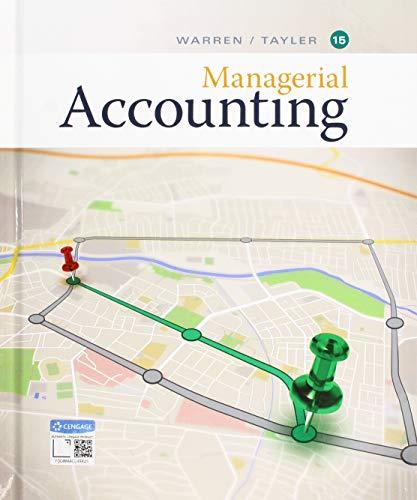 Managerial AccountingAccountingISBN:9781337912020Author:Carl Warren, Ph.d. Cma William B. TaylerPublisher:South-Western College Pub
Managerial AccountingAccountingISBN:9781337912020Author:Carl Warren, Ph.d. Cma William B. TaylerPublisher:South-Western College Pub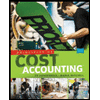 Principles of Cost AccountingAccountingISBN:9781305087408Author:Edward J. Vanderbeck, Maria R. MitchellPublisher:Cengage Learning
Principles of Cost AccountingAccountingISBN:9781305087408Author:Edward J. Vanderbeck, Maria R. MitchellPublisher:Cengage Learning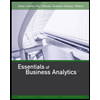 Essentials of Business Analytics (MindTap Course ...StatisticsISBN:9781305627734Author:Jeffrey D. Camm, James J. Cochran, Michael J. Fry, Jeffrey W. Ohlmann, David R. AndersonPublisher:Cengage Learning
Essentials of Business Analytics (MindTap Course ...StatisticsISBN:9781305627734Author:Jeffrey D. Camm, James J. Cochran, Michael J. Fry, Jeffrey W. Ohlmann, David R. AndersonPublisher:Cengage Learning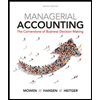 Managerial Accounting: The Cornerstone of Busines...AccountingISBN:9781337115773Author:Maryanne M. Mowen, Don R. Hansen, Dan L. HeitgerPublisher:Cengage Learning
Managerial Accounting: The Cornerstone of Busines...AccountingISBN:9781337115773Author:Maryanne M. Mowen, Don R. Hansen, Dan L. HeitgerPublisher:Cengage Learning Financial And Managerial AccountingAccountingISBN:9781337902663Author:WARREN, Carl S.Publisher:Cengage Learning,
Financial And Managerial AccountingAccountingISBN:9781337902663Author:WARREN, Carl S.Publisher:Cengage Learning,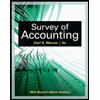 Survey of Accounting (Accounting I)AccountingISBN:9781305961883Author:Carl WarrenPublisher:Cengage Learning
Survey of Accounting (Accounting I)AccountingISBN:9781305961883Author:Carl WarrenPublisher:Cengage Learning





